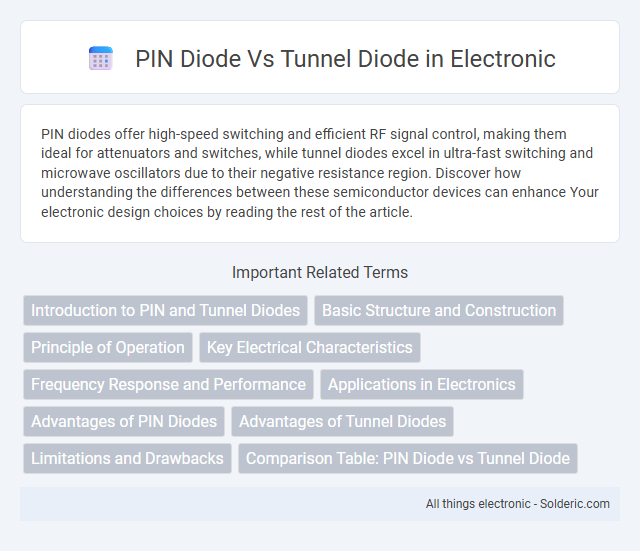PIN diodes offer high-speed switching and efficient RF signal control, making them ideal for attenuators and switches, while tunnel diodes excel in ultra-fast switching and microwave oscillators due to their negative resistance region. Discover how understanding the differences between these semiconductor devices can enhance Your electronic design choices by reading the rest of the article.
Comparison Table
| Feature | PIN Diode | Tunnel Diode |
|---|---|---|
| Structure | p-type, intrinsic, n-type layers | Highly doped p-n junction |
| Operation Principle | Carrier injection and recombination | Quantum mechanical tunneling |
| Switching Speed | Moderate (nanoseconds) | Ultra-fast (picoseconds) |
| Applications | RF switches, attenuators, photodetectors | High-speed oscillators, amplifiers |
| IV Characteristics | Linear in forward bias | Negative resistance region |
| Power Handling | High power | Low power |
| Noise | Low noise | Relatively higher noise |
| Cost | Generally lower | Generally higher |
Introduction to PIN and Tunnel Diodes
PIN diodes feature a wide intrinsic semiconductor layer between the p-type and n-type regions, allowing them to handle high voltage and act as RF switches or attenuators. Tunnel diodes use quantum mechanical tunneling with a heavily doped p-n junction to achieve very fast switching speeds and negative resistance characteristics in high-frequency oscillators. Your choice depends on whether you need high-speed switching with negative resistance (tunnel diode) or efficient signal control and high power handling (PIN diode).
Basic Structure and Construction
A PIN diode features a layered structure consisting of p-type, intrinsic, and n-type semiconductor regions, with the intrinsic layer creating a wide depletion zone crucial for high-frequency and RF applications. In contrast, a tunnel diode is constructed with heavily doped p-type and n-type regions that result in a thin depletion region, enabling quantum tunneling and negative resistance behavior. Understanding these fundamental structural differences helps you choose the right diode type for high-speed switching or signal modulation tasks.
Principle of Operation
A PIN diode operates by using an intrinsic layer sandwiched between the p-type and n-type regions, allowing it to function as a variable resistor at RF and microwave frequencies, controlled by the injected charge carriers. A tunnel diode exploits quantum mechanical tunneling due to its heavily doped p-n junction, resulting in a negative resistance region that enables high-speed switching and oscillation. Your choice depends on whether you require controlled resistance modulation in high-frequency applications or ultrafast switching characteristics.
Key Electrical Characteristics
PIN diodes exhibit high voltage handling and low forward resistance due to their intrinsic layer, making them ideal for RF switching and attenuation. Tunnel diodes showcase negative resistance and extremely fast response times attributed to quantum tunneling, suitable for high-frequency oscillators and amplifiers. Unlike PIN diodes, tunnel diodes operate effectively at very low forward voltages with high peak current densities.
Frequency Response and Performance
PIN diodes exhibit a wide frequency response, typically operating efficiently from RF to microwave frequencies, making them suitable for high-frequency switching and attenuation applications. Tunnel diodes offer extremely fast switching speeds due to their negative resistance region, excelling in microwave oscillators and high-frequency detectors but usually with limited power handling compared to PIN diodes. Performance-wise, PIN diodes provide stable operation over a broad frequency range with low distortion, while tunnel diodes deliver superior speed at very high frequencies but with increased complexity in biasing and noise management.
Applications in Electronics
PIN diodes are widely used in RF switches, attenuators, and photodetectors due to their ability to handle high-frequency signals and fast switching speeds. Tunnel diodes excel in high-speed oscillators and amplifiers, benefiting from their negative resistance region for ultra-fast switching and frequency generation. Understanding these unique electronic applications helps you select the appropriate diode type for high-frequency circuit design and signal modulation.
Advantages of PIN Diodes
PIN diodes offer superior performance in high-frequency switching and attenuators due to their intrinsic layer, which increases carrier lifetime and improves signal handling. They provide excellent linearity, low distortion, and high isolation in RF and microwave applications compared to tunnel diodes. Your design benefits from the robustness and reliability of PIN diodes in power control and RF switching circuits.
Advantages of Tunnel Diodes
Tunnel diodes offer exceptionally high-speed switching due to their negative resistance region, making them ideal for microwave and high-frequency applications. Their low power consumption and high-frequency oscillation capabilities outperform PIN diodes in ultra-fast and low-voltage circuits. You can leverage tunnel diodes for reliable performance in oscillators, amplifiers, and switching devices where speed and frequency response are critical.
Limitations and Drawbacks
PIN diodes exhibit limitations such as slower switching speeds and higher forward voltage drops compared to tunnel diodes, restricting their use in ultra-high-speed applications. Tunnel diodes, despite their extremely fast response times, suffer from low output power and sensitivity to temperature variations, which can cause instability in circuits. Both devices face drawbacks in specific frequency ranges: PIN diodes show reduced performance at very high frequencies, while tunnel diodes have limited power handling capabilities and are prone to negative resistance region-induced oscillations.
Comparison Table: PIN Diode vs Tunnel Diode
PIN diodes feature a wide intrinsic layer, enabling high-frequency switching and signal attenuation with low distortion, ideal for RF applications. Tunnel diodes exhibit negative resistance due to quantum tunneling, allowing ultra-fast switching and high-frequency oscillations but with lower voltage and current capacity. Your choice depends on whether you prioritize linearity and power handling (PIN diode) or speed and frequency performance in low-signal environments (tunnel diode).
PIN diode vs tunnel diode Infographic

 solderic.com
solderic.com